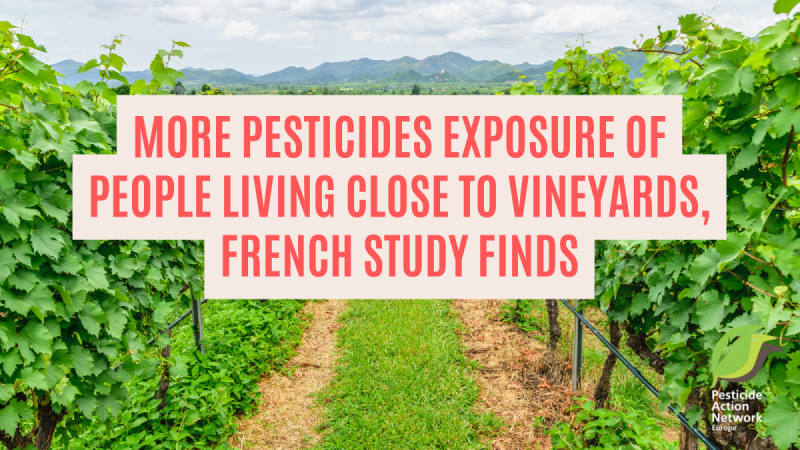Living near a vineyard can have serious health consequences. According to a national study in France, people who live close to vineyards are more exposed to pesticides than those who live farther away. The research was carried out by Santé Publique France and the National Food Safety and Environment Agency (ANSES) in more than 250 locations across six wine-growing regions. Young children, aged between three and six years, are particularly affected by this exposure. This adds to the findings of PAN Europe and its members, who call for much larger buffer zones to protect citizens living near fields where toxic substances are applied.
The PestiRiv research project involved testing urine, hair, indoor and outdoor air, as well as dust. Almost 2,700 people (1,946 adults and 742 children) took part in the study carried out in 2021 and 2022. [1] The results were clear: residents living within 500 metres of vineyards had higher levels of pesticides in their bodies and homes than those living further, particularly during spraying periods.
“The results of PestiRiv officially confirm what Générations Futures has been demonstrating for years through its work: residents living near cultivated areas (and undoubtedly not only vineyards) are more exposed to pesticides than the rest of the population, and this exposure increases the closer they live to the crops.” says François Veillerette, spokesperson for Générations Futures.
This research provides, for the first time and on a large scale, a detailed description of environmental pollution and the resident population in wine-growing areas in a country where 4% of citizens live near these crops. There are conclusive results due to the diversity of samples and coincide with those of the few studies conducted in the USA and the Netherlands.
Courts are starting to recognise the threat faced by citizens living near the crops. Last year the French court in Versailles ruled that "Good Neighbor" charters allow too little distance for pesticide spraying near homes. It was a significant victory for our member Générations Futures and six other NGO who filed the appeals against these documents. More recently, the Court of Appeal in the south of the Netherlands ruled that citizens have to be protected against pesticides with a 250 meter buffer strip between houses and fields. [2] [3]
Main victims: young children
Agriculture activities are the main drivers of environmental contamination—polluting the air, outdoor spaces, household dust—and even showing up in biological markers like urine and hair. According to the French findings, young children aged three to six are the most affected by pesticide exposure.
People living near vineyards face significantly higher exposure than those living farther away (over 5 km from the nearest vines). In wine-growing areas, urinary contamination is 15% to 45% higher, while pesticide concentrations in the air can reach up to twelve times those of distant regions. In household dust, the difference is even more dramatic— levels can be up to 1000% higher.
Similar evidence in other EU countries
Vineyards were the crop chosen for this study because vines are permanent, often located near homes, and generally subject to significant applications of pesticides. Substances found included well-known chemicals such as glyphosate; as well as vineyard-specific fungicides that have been linked with Parkinson's as Folpet, or metiram. [4] These can travel beyond treated areas through spray drift or evaporation and later settle back onto the soil. Since spring and summer 2022 were hot and dry, fewer treatments were needed, meaning exposure could be even higher in wetter years.
Another PAN Europe research in South Tyrol, Italy, showed pesticide contamination in playgrounds situated in a major apple-growing region. Traces of pesticides were detected even in areas with buffer zones as wide as 30 meters, revealing the airborne of pesticides has been underestimated. The Dutch citizens network Meten = Weten, in cooperation with PAN Netherlands, has also shown in its research how pesticides are spread into people’s gardens, houses, playgrounds and even nature reserves.
In addition, a 2025 German study showed that pesticides spread much farther from fields than previously thought. [5] Led by Professor Dr. Carsten Brühl, scientists tested topsoil, vegetation, streams, and puddles at 78 locations over a 180 km area, ranging from remote UNESCO mountain forests to farmland in the Upper Rhine. Residues were found in 97% of the samples. The team detected 63 different pesticides in total.
Need to take action
Therefore, the French agencies recommend reducing the use of pesticides to what is strictly necessary. The study shows that the quantity of products used and the proximity of homes to vineyards are the two main factors contributing to exposure. This observation confirms the need to act on the source of emissions in order to limit the exposure of people living closest to crops.
PAN Europe advocates for a significant reduction in pesticide use and an urgent expansion of buffer zones of at least 150 m for toxic pesticides to adequately protect public health.
Read more
- We need effective buffer zones - against a cloud of pesticides
- PestiRiv: finally, data that recognises the actual exposure of residents living near wine-growing areas to pesticides (Website Générations Futures)
Notes
[1] PestiRiv: results of the national study on pesticide exposure of residents of wine-growing areas
[2] Dutch court of appeal orders 250 m buffer strip between field and houses – ban on lily cultivation
[3] Court victory in France: residents' need better protection from pesticide spraying
[4] A haze of pesticides over the land
[5] Pesticides contaminate on a landscape scale - far beyond the fields
